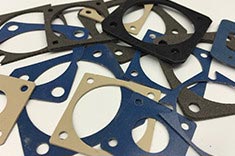EMI Shielding Products
- Custom Gasket Fabrication
- Connector Gaskets
- Bonded O Ring
- Custom Gaskets
- Conduct-O-Knit Knitted Wire Mesh
- Conduct-O-Seal Combo Gasket
- Conduct-O-Elastomer
- Conduct-O-Seal Oriented Wire in Silicone Gasket Material
- Conduct-O-Mesh Tape
- Conduct-O-Foam
- Conduct-O-Bond
- Optical Filters For Electronic Displays
- Shielded Vent Panels
- ESC Board Level Shielding
- 300 Series
Tips for Gasket Junction Design
 Designing the junction for an EMI shielding gasket requires meticulous precision to ensure that electronic devices are adequately protected against electromagnetic interference (EMI). The junction, which is the interface between the gasket and the device housing, plays a critical role in the overall effectiveness of the EMI shield. We can provide key considerations and examples to guide engineers and designers in creating effective EMI shielding solutions.
Designing the junction for an EMI shielding gasket requires meticulous precision to ensure that electronic devices are adequately protected against electromagnetic interference (EMI). The junction, which is the interface between the gasket and the device housing, plays a critical role in the overall effectiveness of the EMI shield. We can provide key considerations and examples to guide engineers and designers in creating effective EMI shielding solutions.
- Importance of Rigidity and Conductivity: A fundamental principle in gasket junction design for shielding EMI is ensuring the gasketing surface is rigid and highly conductive. For example, the ideal junction should feature a recessed design that fully encapsulates the gasket, maximizing contact and minimizing electromagnetic leakage. Metal surfaces in contact with the gasket should be treated to resist corrosion or coated with conductive materials like nickel to maintain electrical continuity even in corrosive environments for effective shielding EMI.
- Ensuring Proper Material Compatibility: Material selection is paramount in preventing galvanic corrosion—a common challenge in junction design for shielding EMI. For instance, when a gasket made of a certain metal is used with a dissimilar metal enclosure, the potential for galvanic corrosion increases unless preventive measures are taken. Compatible materials, such as pairing silver-plated aluminum gaskets with aluminum enclosures, can mitigate this risk for shielding EMI. Additionally, applying protective coatings or employing materials that naturally resist corrosion while maintaining conductivity is crucial for long-term reliability in shielding EMI.
- Grooved Designs for Enhanced Performance: Incorporating grooves into the flange design can significantly improve the sealing effectiveness of the gasket for shielding EMI. A single-groove design is often sufficient for many applications, effectively limiting gasket compression and ensuring metal-to-metal contact at the flange junction. This design enhances the EMI shielding performance and helps distribute the compression force evenly, reducing the risk of over-compression and guaranteeing a consistent seal for shielding EMI.
- Compression and Deflection Considerations: Understanding the compression and deflection limits of the chosen gasket material is essential for ensuring that the junction design can accommodate these factors without compromising the seal for shielding EMI. For example, solid conductive O-rings typically have a deflection limit of 25 percent, meaning the groove design must allow for adequate compression without exceeding this limit. Proper groove dimensions can prevent excessive compression, which could otherwise lead to gasket failure or reduced shielding effectiveness for EMI.
- Addressing Environmental Factors: The junction design must also consider environmental factors that could impact the effectiveness of the EMI shield for shielding EMI. For instance, in applications where the device is exposed to harsh environmental conditions, the gasket material and junction design should provide EMI shielding and protection against moisture, dust, and other contaminants. Utilizing materials like silicone, known for their environmental resistance, in combination with appropriate groove designs, can achieve this dual functionality for shielding EMI.
Example of Effective Junction Design
A well-designed EMI gasket junction for an aerospace application might employ a silicone EMI gasket with a custom-designed groove in the device's aluminum enclosure. The groove is precisely engineered to allow for optimal compression of the gasket, ensuring a tight seal against electromagnetic interference while resisting the extreme temperatures and pressures encountered in aerospace environments. The aluminum surface is treated with a conductive coating to prevent corrosion and maintain electrical continuity across the junction for effective shielding EMI.
Effective junction design for EMI shielding gaskets requires careful consideration of rigidity, conductivity, material compatibility, compression limits, and environmental factors. By adhering to these principles and employing strategic design choices, engineers can create EMI shielding solutions that protect electronic devices from interference and ensure their long-term reliability and performance for shielding EMI.



